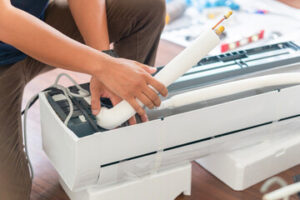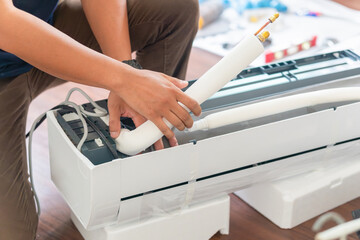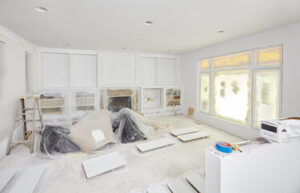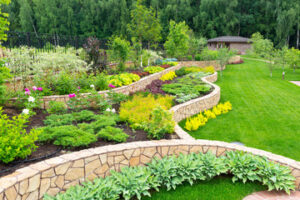Ausco Air Heating & Air Conditioning systems play a key role in maintaining indoor comfort. They regulate temperature and humidity levels, ensuring a comfortable environment year-round. Efficient systems improve air quality and reduce energy consumption. Professional installation and maintenance enhance system performance and longevity.
Heating systems provide warmth during cold months. Furnaces, heat pumps, and boilers are common heating solutions. Proper installation ensures even heat distribution and energy efficiency. Regular maintenance prevents breakdowns and extends the system’s lifespan.
Air conditioning systems cool indoor spaces during warm seasons. Central air conditioners, split systems, and portable units offer various cooling solutions. Efficient systems remove excess moisture and improve air circulation. Professional servicing keeps units running smoothly.
Thermostats control temperature settings for heating and cooling systems. Modern smart thermostats allow remote adjustments and programming. Accurate temperature control enhances comfort and reduces energy waste. Proper calibration ensures consistent performance.
Air ducts distribute heated or cooled air throughout a building. Leaks and blockages reduce efficiency and increase energy costs. Professional cleaning and sealing improve airflow and temperature regulation. Well-maintained ducts enhance system performance.
Air filters remove dust, pollen, and allergens from the air. Clogged filters reduce airflow and strain the system. Regular filter replacement maintains air quality and system efficiency. Clean filters improve respiratory health and comfort.
Zoning systems divide a building into separate temperature zones. Independent thermostats control each zone for personalized comfort. Zoning reduces energy consumption by heating or cooling only occupied areas. Professional installation ensures proper system balance.
Heat pumps provide both heating and cooling functions. They transfer heat from one location to another using refrigerant. Reversible operation allows for year-round comfort. Proper installation maximizes efficiency and performance.
Humidity control improves indoor comfort and prevents mold growth. Dehumidifiers remove excess moisture from the air. Humidifiers add moisture when air becomes too dry. Balanced humidity levels protect furnishings and improve air quality.
Energy-efficient systems reduce operating costs and environmental impact. High-efficiency models use advanced technology to maximize performance. Professional installation ensures proper system sizing and configuration. Reduced energy consumption lowers utility bills.
Routine maintenance extends the life of heating and cooling systems. Professional technicians inspect, clean, and repair components as needed. Preventive maintenance prevents unexpected breakdowns and costly repairs. Well-maintained systems operate more efficiently.
Air circulation promotes even temperature distribution and improved comfort. Ceiling fans and ventilation systems enhance airflow. Proper airflow reduces hot and cold spots within a space. Balanced circulation supports consistent comfort.
Ductless mini-split systems provide targeted heating and cooling. Indoor units are installed in individual rooms for personalized comfort. Ductless systems are ideal for retrofitting older buildings. Professional installation ensures proper refrigerant flow and system balance.
Insulation improves the efficiency of heating and cooling systems. Properly insulated walls, ceilings, and floors reduce heat loss and gain. Insulation helps maintain stable indoor temperatures. Professional installation ensures thorough coverage and performance.
Ventilation systems remove stale air and introduce fresh air into a building. Mechanical and natural ventilation methods improve indoor air quality. Balanced ventilation reduces humidity and pollutant buildup. Professional design and installation optimize airflow.
Air conditioning refrigerants absorb and release heat during the cooling process. Proper refrigerant levels ensure efficient operation. Low refrigerant levels reduce cooling capacity and increase energy use. Professional servicing ensures correct refrigerant balance.
Heating system efficiency depends on fuel type and delivery method. Gas, electric, and oil-based systems have varying efficiency levels. Proper system sizing and installation improve performance. Professional adjustments maintain consistent heating.
Air conditioning compressors circulate refrigerant and regulate pressure. Compressor issues reduce cooling efficiency and increase energy use. Regular servicing prevents compressor failure. Professional repairs restore proper function and cooling capacity.
System diagnostics identify performance issues before they become major problems. Technicians use advanced tools to test system components. Early detection prevents costly breakdowns and repairs. Regular diagnostics improve system reliability.
Thermal comfort depends on temperature, humidity, and airflow balance. Proper system design ensures even distribution and consistent performance. Adjusting thermostats and dampers improves comfort levels. Professional tuning enhances thermal balance.
Programmable thermostats allow users to set heating and cooling schedules. Automated adjustments reduce energy use during unoccupied periods. Smart thermostats learn user preferences for improved comfort. Professional installation ensures accurate sensor placement.
Condensate drains remove moisture produced during the cooling process. Clogged drains cause water damage and reduce efficiency. Regular cleaning prevents blockages and overflow. Professional maintenance keeps drains clear and functional.
Air handling units circulate and condition indoor air. Filters, fans, and coils regulate airflow and temperature. Proper maintenance ensures efficient operation and consistent comfort. Professional servicing prevents system strain and failure.
Heating system igniters and pilot lights enable combustion in gas systems. Faulty igniters reduce heating capacity and increase fuel use. Professional servicing ensures reliable ignition and safety. Replacing worn components prevents system failure.
Air conditioning evaporator coils absorb heat from indoor air. Dirty or frozen coils reduce cooling capacity. Professional cleaning and inspection restore performance. Proper airflow prevents coil freezing and damage.
Heating system heat exchangers transfer heat from combustion to indoor air. Cracked heat exchangers pose safety risks and reduce efficiency. Professional inspection detects cracks and corrosion. Replacing damaged exchangers restores safe operation.
Air conditioning condensers release heat absorbed by refrigerants. Dirty or damaged condensers reduce cooling capacity. Professional cleaning improves heat exchange efficiency. Regular maintenance prevents overheating and system strain.
Blower motors circulate heated and cooled air through ductwork. Worn or malfunctioning motors reduce airflow and system efficiency. Professional repair restores motor function and airflow. Proper lubrication reduces friction and noise.
Indoor air quality impacts comfort and health. Air purifiers and ventilation systems reduce pollutants and allergens. Professional testing identifies air quality issues. Proper filtration and airflow improve respiratory health.
Heating and cooling load calculations determine proper system sizing. Oversized systems cycle frequently and waste energy. Undersized systems struggle to maintain temperature. Professional load assessments ensure optimal system size and performance.
Defrost cycles prevent ice buildup on heat pump coils. Malfunctioning defrost controls reduce heating capacity and increase energy use. Professional servicing restores proper cycle timing. Efficient defrosting improves heat pump performance.
Air conditioning fan motors drive airflow through evaporator and condenser coils. Faulty motors reduce cooling capacity and increase strain on the system. Professional repair restores fan function and efficiency. Regular lubrication prevents wear and tear.
Heating and cooling system noise levels impact comfort. Loose components and worn bearings increase noise levels. Professional adjustments reduce vibrations and improve operation. Quiet systems enhance user comfort and satisfaction.
Air ducts require proper insulation to maintain air temperature during distribution. Poorly insulated ducts lose heating and cooling capacity. Professional installation ensures consistent airflow and temperature regulation. Insulated ducts improve system efficiency.
Seasonal maintenance prepares heating and cooling systems for peak performance. Pre-season inspections and adjustments prevent breakdowns. Professional servicing includes cleaning, lubrication, and calibration. Well-maintained systems operate efficiently year-round.
Energy recovery ventilators transfer heat and moisture between incoming and outgoing air streams. Proper installation ensures balanced airflow and temperature regulation. Professional servicing restores heat exchange efficiency. Improved ventilation reduces heating and cooling loads.
Combustion analysis ensures safe and efficient heating system operation. Professional testing measures fuel mixture and exhaust quality. Proper adjustments improve combustion efficiency and reduce emissions. Safe operation enhances system longevity and performance.
Professional air heating and air conditioning services ensure that systems operate at peak efficiency. Expert installation, maintenance, and repairs enhance comfort and reduce costs. Efficient systems improve indoor air quality and temperature control. Reliable performance supports long-term comfort and energy savings.




